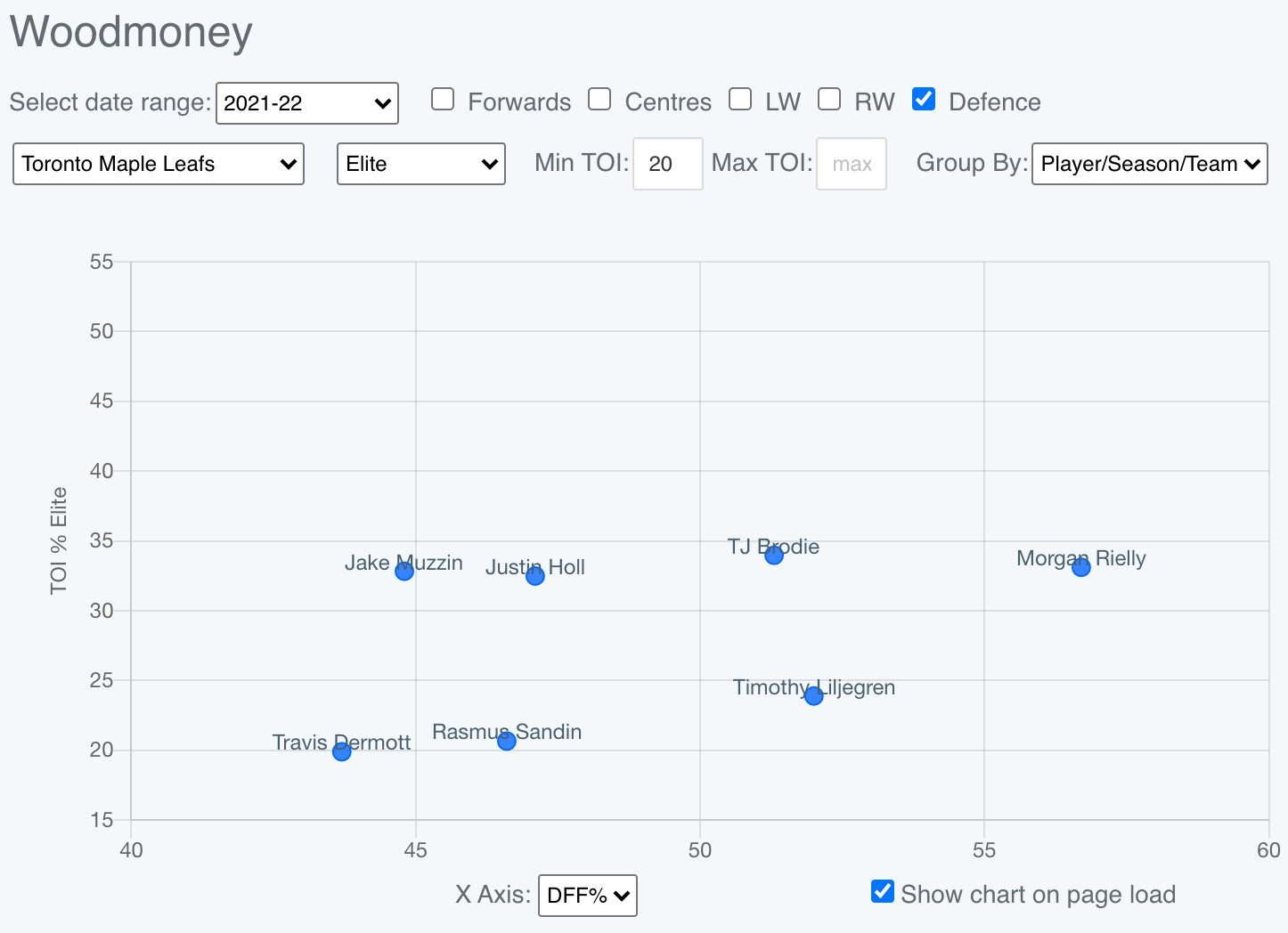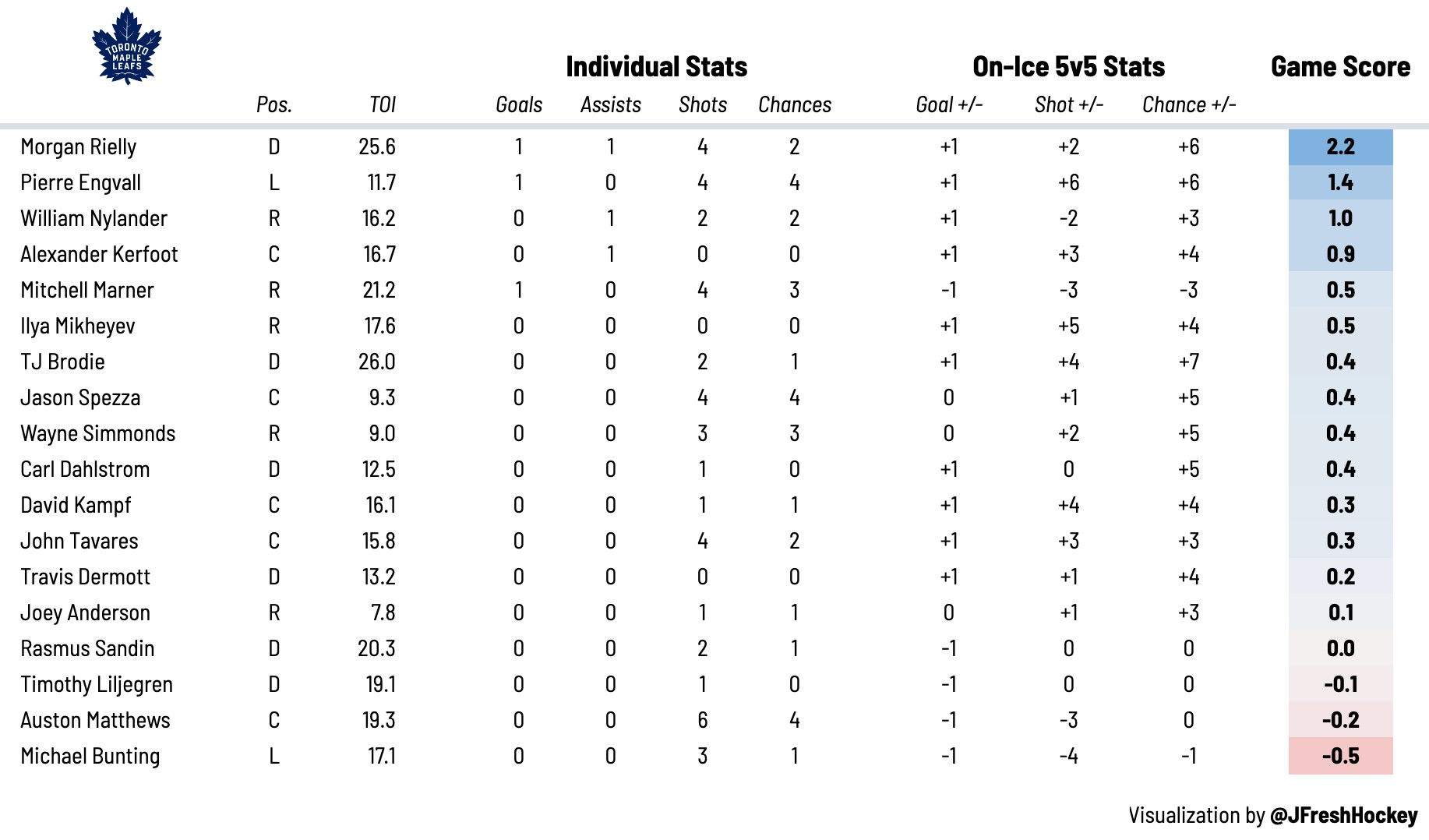A clash of styles
Barry Trotz’s Islanders played their game, clogging up the slot in the defensive zone and finishing every single check in the offensive zone, much to the delight of their home crowd.
Sheldon Keefe’s Leafs responded by playing their game: dominating puck possession with crisp passing, smooth transitions through the neutral zone, and a barrage of scoring chances in the offensive zone.
As you’ll see from the individual player grades, this was actually an off-night for most of Toronto’s big guns up front. Morgan Rielly and Mitch Marner both provided some standout performances offensively, but it was the Engvall-Mikheyev duo on the third line that helped provide some energy and depth scoring.
It was also Petr Mrazek’s best start of the season, which should help quell the negativity in Leafs Nation for… at least another 24 hours? With that in mind, let’s dive into some positivity. Toronto dominated the run of play in Long Island, so we have a lot of strong performances to discuss.
It’s time for some Leafs Report Cards!
5 Stars
The Rielly-Brodie Pair — With Jake Muzzin out of the lineup — or even when he’s in the lineup if we’re being honest — the Rielly-Brodie pair is tasked with taking on the toughest minutes at even strength. They’ve done a phenomenal job at tilting the ice in those difficult shifts, with Morgan Rielly advancing the puck up the ice with his passing and TJ Brodie providing textbook rush defense. I could go on and on about Brodie’s ability to defend speed on 1v1 rushes or take away passing lanes through the middle of the ice, but I’ll stop myself before you get too annoyed.
Rielly tends to get most of the praise on the top pair because of his offensive ability, which is understandable when you watch him send Mitch Marner up the ice for a breakaway goal on the PK — or when Rielly finds open ice in the offensive zone and fires a one-timer past Semyon Varlamov. That puts Rielly on pace for 71 points this season, which should get him some serious Norris consideration when you factor in how well he’s impacting the game in his 24:14 per game.
One of my favourite ways of measuring 5v5 impact is by looking at how well a defenseman does in their minutes against “elite” competition on the site PuckIQ.com. They have a stat called “Dangerous Fenwick” (or Dangerous Fenwick For % — DFF%) that resembles expected goals, in that it weights shots from closer to the net as more valuable than low-percentage wristers from the blueline.
They say a picture is worth a thousand words, which is why I love graphs like these so much.
- Rielly has been Toronto’s most valuable defenseman this season
- Muzzin-Holl haven’t been effective in their shutdown minutes
- Brodie is handling tough shifts at an above-average rate
- Liljegren probably deserves a closer look in the top four
As fun as it is to grade players after single-game performances, we get a much better read on things when we look at a large sample of minutes. All of the evidence indicates Rielly has been performing at a #1D level this year, while Brodie’s strong complementary play has helped Toronto form one of the better pairings in hockey.
Mitch Marner (RW, #16) — It wasn’t Auston Matthews’ strongest 200-foot game on Saturday night, which opened the door for Marner to do more of the heavy lifting at 5v5. He was all over the ice in this one, backchecking hard to prevent odd-man rushes against including a defensive coverage that Matthews — of all people — had blown.
Marner also did a great job of providing support to his defensemen in the offensive zone, rolling up high to the blue line to give them an outlet. This is something he’s always done well, holding his stick out emphatically towards the open ice so he can “show” his teammate where he wants the puck. It’s such a minor detail, but it really helps the defenseman along the wall complete a quick pass under pressure.
I do have some nit-picks on the power play, mostly that Marner was patrolling the left wall exclusively in this game. The Leafs have shown that they want to switch things up on PP1 to keep opposing penalty killers on their tows, but Marner is at his most effective when he’s constantly roaming around the offensive zone, constantly “switching” places with his teammates on the top unit. I’d like to see more of that in his next game.
MikhEngvall — Last season, these two performed really well in third-line minutes together, controlling 55 percent of the scoring chances at 5v5 in the 282 minutes where they shared the ice, which is a pretty decent sample, all things considered. This year, they’re rocking a 64 percent in that department, albeit in only 55 minutes so far.
Their combination of size, speed, and length makes them a nuisance to get through in the neutral zone. I’ve said this before, but they remind me of the elite defenders you’ll see in the NBA, who combine massive wingspans with quick feet to stay in front of their opponent.
I’m becoming more and more impressed with how these two use those tools to advance play up the ice offensively. We’ve seen Pierre Engvall do it for a while now, so maybe we shouldn’t be as surprised when Ilya Mikheyev loads up with speed and finds a way to power his way through the neutral zone. He also completed a few great passes in these situations to help his team gain the zone with speed.
We should probably mention the Engvall buzzer-beater at some point here. Again, using his disruptive combination of length and speed, Mikheyev was able to force a turnover along the boards. From there, Engvall was able to scoop up the puck and toe drag his way around the defender and goaltender for his best goal of the season.
I don’t know how often we should expect to see that from these two, but there’s a long track record of them having success together. As much as the fourth line could use Engvall’s puck transporting these days, it would genuinely pain me to see these two separated. They play so well together.
4 Stars
Petr Mrazek (G, #35) — He’s going to be a key part of the Leafs‘ success down the stretch here. As frustrating as it was for Mrazek to only play in four of Toronto’s first 37 games, my guess is he’ll get at least 15-20 starts in the back half of the season. Jack Campbell’s play has noticeably dipped lately, partly due to some inevitable regression but also partly due to fatigue.
Saturday night was a nice showcase for Mrazek, showing his teammates and coaching staff that he could be trusted in games other than the second half of back-to-backs. He did a great job cutting down the angle when he needed to, coming out of his blue paint on a partial breakaway from Cal Clutterbuck. Mrazek also showed some solid rebound control, velcro-ing a few pucks from distance into his stomach for a much-needed whistle.
Wayne Simmonds (RW, #24) — After a few nights in a row of struggling to even get a cycle going in the offensive zone, Simmonds helped the fourth line generate some legitimate scoring chances in this game. He looked noticeably more engaged on the forecheck, using his strength to finish checks and win 50-50 battles for loose pucks.
Most importantly, Simmonds was an animal in and around the crease, getting shots in tight off of wraparounds and rebounds. He’s still among the leaders in shot quality this season and he showed why on Saturday night. When you fight hard for body position in front of the net, good things will eventually happen.
Expected goals per time played leaders. (Minimum 200 minutes played 5 on 5) https://t.co/N8l8RcVmX3 pic.twitter.com/Q9mBO9V6BS
— MoneyPuck.com (@MoneyPuckdotcom) January 22, 2022
He’s still pretty snakebitten when you look at the difference between his expected goals and actual goals, which means we should expect the red light to go off more often if he keeps getting chances from in tight at this rate.
As a side note, there are a lot of Leafs on that list, which is a very good thing.
3 Stars
Travis Dermott (RD, #37) — I’m not quite sure how to evaluate a defenseman who’s forced to play with a non-NHL D partner, but here we are, taking a look at the Dahlstrom-Dermott pairing. I didn’t think Dermott made too many mistakes defensively or on the breakout. The bigger problem was that he couldn’t trust his partner to receive a simple pass in the DZ, forcing Dermott to do all of the work himself.
The end result was a bit of a mixed bag. How much of that do you put on Dermott? Personally, I wouldn’t put too much of it on him, but I can understand the frustration with his game considering he’s never taken that “next step” a lot of us thought he would by now.
David Kampf (C, #64) — His wingers were the real difference-makers in transition and offensively, which leaves the defense for Kampf. As always, he was trustworthy in the faceoff circle and on the PK.
At 5v5, I still struggle with evaluating him because he rarely turns the puck over, completing his next pass when he’s in trouble. He also rarely makes notable plays up the ice. It’s almost as if he’s playing rugby, making a lateral or backward pass to a teammate instead of going up ice. I think this is more of a feature than a bug with Kampf’s game, but it’s something I’ve been noticing a lot lately.
The Kerfoot-Tavares-Nylander Line — I didn’t think they generated a ton of dangerous looks in the game, but both Alex Kerfoot and William Nylander completed some east-west passes in the offensive zone to an activating defenseman. Those are high-percentage plays that help increase your expected shooting percentage — just ask Rielly, who had a lot of net to shoot at on his one-timer goal that Kerfoot and Nylander picked up assists on.
It was a relatively low-event night for them — just two high-danger scoring chances (both for the Leafs) and six shots (4-2 Leafs) in over 10 minutes of 5v5 ice time. Big picture, this is something to keep an eye on: They’ve spent the most time together of any trio this season (223 minutes), and they still haven’t crossed the 50 percent barrier in terms of shot differential. They’re getting outshot (49.8%) at 5v5, which shouldn’t really happen on a line with Tavares and Nylander.
2 Stars
The Sandin-Liljegren Pair — As an analyst, I think my biggest blindspot is failing to recognize how difficult it is for defensemen to move up the lineup and succeed in more difficult minutes. After watching Rasmus Sandin sail smoothly on Toronto’s third pair — leading the NHL in 5v5 scoring chance differential — I assumed he’d be able to hold his head above water against opposing top sixes.
Sandin still has some growing to do defensively, getting walked pretty badly by Anders Lee earlier in the game and then again by Matt Barzal in the third period, which led to a Grade-A chance for the Islanders, followed by a Leafs penalty. Sandin’s puck-moving ability is still why I have faith in his ability to eventually grow into that top-four role, but there’s also a lot of evidence he isn’t quite ready for it yet.
When it comes to Timothy Liljegren, I have more reason to believe he can handle more of the tougher shifts this season. I know a puck bounced over his stick and led to a Zach Parise goal. I also know how rough it looked for his pair when defending in-zone against the cycle. Both of these young defensemen need to do a better job of boxing out their man and winning back loose pucks after the initial shot.
With all of that said, I still see a player who can make crisp passes out of his own zone and defend the rush competently against opposing top-six players. Despite a few rough games lately, I’d still like to see what a Muzzin-Liljegren pairing could accomplish over a longer stretch of games.
The Bunting-Matthews Duo — These two have been fantastic together all year, but sometimes you have an off night. Michael Bunting filled up his quota with another drawn penalty, but otherwise really struggled to impact the game. His passing was really off in transition. Usually, we see him complete passes out of tough spots in the neutral zone to get the puck onto Marner or Matthews’ stick. That wasn’t the case on Saturday night, and as a result, the top line didn’t have the puck in the offensive zone very often.
Let’s be honest, though, the MVP candidate is the main driving force behind this line’s success. Other than his first shift, Auston Matthews didn’t look like…Auston Matthews. He was having trouble carrying the puck up the ice, getting to his spots offensively, and even completing simple passes in the offensive zone.
Again, sometimes good players have bad games.
The Other Fourth Liners — Wayne Simmonds had a great game. His linemates did not. I can understand why the Leafs wanted to give Joey Anderson a chance to prove himself considering how ineffective Kyle Clifford has looked recently at the NHL level. Anderson has a quick release, but honestly, I’m not seeing too many NHL-calibre tools outside of that.
It’s not the end of the world if Anderson doesn’t crack this roster. It’s a much bigger deal if Jason Spezza keeps playing like this. He hasn’t looked very dangerous offensively lately, failing to gain the zone with speed at 5v5. He’s missing on passes he usually completes and taking lazy penalties by not moving his feet. He might need a move to the wing to get him going.
1 Star
Carl Dahlstrom (LD, #48) — I never love being mean to an AHL player who gets called up due to injuries (or COVID) and struggles at the next level. In the times I’ve watched Dahlstrom against NHL competition, his puck-moving out of the defensive zone just isn’t up to snuff. I like that he showed a willingness to activate into the rush when the situation called for it, but there’s so little he can do with the puck on his stick that it never led to much offensively.
Considering how much the Leafs have prioritized skill and puck-moving ability since Dubas took over, I’m frankly a bit surprised that it’s a 6’4 defenseman getting a look with the big club instead of a Joey Duszak or Filip Kral. The way I see it, they represent where the NHL is going, whereas Dahlstrom represents a more outdated archetype of defensemen from the past.
Heat Map
Here’s a quick look at where each team’s shots were coming from at even strength, courtesy of Natural Stat Trick.
 The Leafs controlled 58 percent of the shots and 68 percent of the scoring chances in this game. The Islanders made a late surge due to score effects, but for the most part, this was another dominant display of puck possession from Toronto.
The Leafs controlled 58 percent of the shots and 68 percent of the scoring chances in this game. The Islanders made a late surge due to score effects, but for the most part, this was another dominant display of puck possession from Toronto.
Game Score
Game score is a metric developed by The Athletic’s Dom Luszczyszyn to measure single-game performance. You can read more about it here.
Tweets of the Night
"And here comes the identity line, with ANOTHER big hit on the forecheck!"
[Leafs break it out cleanly]
[Leafs establish OZ possession]
[Leafs create chance after chance from the slot]— william nylander's 69% ipp (nice) (@mostlyleafies) January 23, 2022
I’d rather have more scoring chances than more hits, but maybe that’s just me.
We just want to say thanks to everyone for the tremendous outpouring of love and support. Clark was a giant of a man, an inspiration, so loving and loved. I know this leaves a hole in the heart of many Long Islanders. If you’d like to donate to his charity https://t.co/w7jOUcr5qm pic.twitter.com/qAXroOp5BZ
— Justin Bourne (@jtbourne) January 23, 2022
The passing of Clark Gillies hit the hockey world pretty hard this weekend. He was one hell of a player — and an even better person from all accounts. I know Gillies had a huge impact on Justin Bourne’s life. He married Gillies’ daughter and now the two of them live happily together with their two children in Toronto.
Justin Bourne has been someone I’ve really looked up to over the years, both as a hockey analyst and a human being. I consider him a mentor and a friend. Even though I never got the opportunity to meet Clark Gillies, it sounds like he helped mold Justin into the person he is today. I’m still growing one day at a time, but Justin has definitely had a major influence on the way I go about my work and try to treat people with respect, even when faced with disrespect.
We’re all connected in different ways. I’d like to think Gillies had an impact on my life tangentially through Justin, which goes to show how you can have a positive impact on the world by simply being a good person.


![Sheldon Keefe on the Maple Leafs’ struggling power play: “[We’ve scored] one out of 11 high-danger chances in tight to the net… We have been in those spots and haven’t converted” Sheldon Keefe, playoff press conference](https://mapleleafshotstove.com/wp-content/uploads/2024/04/keefe-pc-game-3-218x150.jpg)

![Jim Montgomery Post Game, Bruins 4 vs. Leafs 2: “[Marchand] still manages to get under people’s skin, yet he doesn’t cross the line” Jim Montgomery, Boston Bruins post game](https://mapleleafshotstove.com/wp-content/uploads/2024/04/jim-monty-pg-to-218x150.jpg)

























![Sheldon Keefe on the Maple Leafs’ struggling power play: “[We’ve scored] one out of 11 high-danger chances in tight to the net… We have been in those spots and haven’t converted” Sheldon Keefe, playoff press conference](https://mapleleafshotstove.com/wp-content/uploads/2024/04/keefe-pc-game-3-100x70.jpg)



![Jim Montgomery Post Game, Bruins 4 vs. Leafs 2: “[Marchand] still manages to get under people’s skin, yet he doesn’t cross the line” Jim Montgomery, Boston Bruins post game](https://mapleleafshotstove.com/wp-content/uploads/2024/04/jim-monty-pg-to-100x70.jpg)

